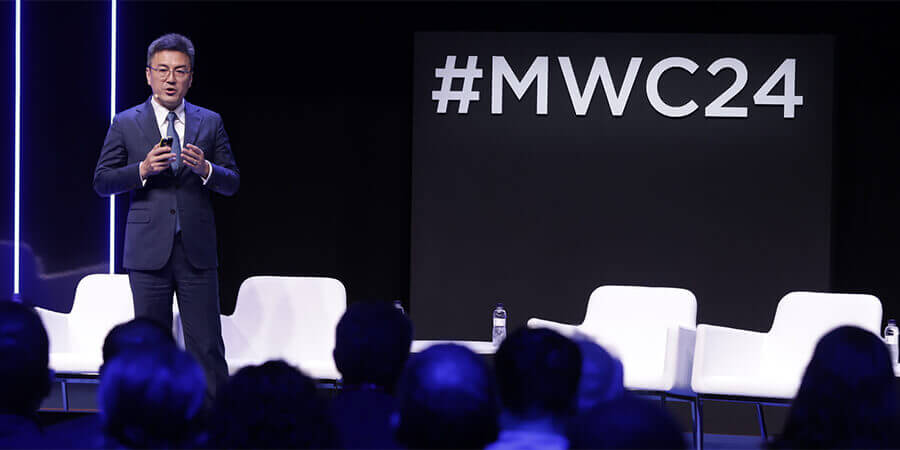Technology has always been at the heart of global economic development, and always will be. Throughout this evolution of technological advancement, there is one trend that significantly stands out as a key driver in this growth trajectory— the time to market (TTM) of products and services and the speed at which they are released by organizations and businesses.
Delivering his presentation entitled “Embracing 5.5G to Unleash Industry Dividends” during MWC2024, Liu Kang, President of ICT Marketing & Solution Sales at Huawei gave an overview of Huawei’s industry-leading expertise on 5G and specifically 5.5G or 5G advanced connectivity and how the industry can benefit from this technology.
To delve deeper into this concept, it’s important to consider the data from ‘The World Economy: A Millennial Perspective’ by Angus Maddison. It reveals that during the 20th-century industrial revolution, which introduced innovations like the steam engine and telegraph, these advancements contributed to over 30% of the global economy over a span of 100 years. Fast forward to the digital age, characterized by the rise of 2G and 3G technologies, and we see a significant shift. The same level of economic contribution, around 30%, was achieved within just 20 years. Now, as we enter the era of the digital intelligent economy, marked by technologies like 5G, 5.5G, Cloud computing, and artificial intelligence (AI), the pace of change accelerates even further. It’s projected that by 2030 and beyond, this 30% milestone will be reached in a mere 5 years, highlighting the rapid evolution and impact of technological advancements.
Furthermore, the region that has witnessed this technological progress closely is the Middle East, specifically the GCC. All the GCC operators boast the deployment of 5G, extending to over 26 million users with tremendous potential for an increase in the number of users. The high-speed and low latency capabilities of 5G have opened the floodgates of business opportunities for all economic industries such as finance, banking, oil and gas, education and health, among many others.
The GSMA, which represents mobile operators worldwide, estimates 5 billion 5G connections by 2030, with the GCC Arab States and developed Asia Pacific countries taking the lead. However, the number of connected devices to access diverse digital services is only going to increase in the future. Hence, the future network architecture will be the decisive factor that will balance the competitive targets of cost efficiency, quality and flexibility in the face of advancements in emerging technologies like Cloud computing, IoT, blockchain, AI, and more. To that end, a more robust technology that can withstand and deliver on the data transfer demands of the modern digital economy is highly anticipated.
The Essence of 5G-Advanced
Fortunately, 5.5G, also known as 5G-Advanced (5G-A), has been recognized by the 3rd Generation Partnership Project (3GPP) under Release 18, and is regarded as the next phase in the 5G evolution. Liu Kang said that one of the most remarkable aspects of transitioning from 5G to 5.5G is the tenfold improvement in network capabilities. “This enhancement facilitates download speeds of 10Gbps and upload speeds of 1Gbps, and the ability to support up to 100 billion IoT connections. Coupled with the integration of advanced intelligence features, this upgrade injects innovation into wireless communication,” said Liu Kang.
This advanced network capacity will boost the industry application developments whereby operators can provide premium connection services that guarantee speed and reliability. Private line business can be extended to private line and ICT services, industrial internet applications can extend from supporting production to core production and IoT applications will grow from low speed to encompassing low, medium and high-speed end-to-end services.
Also Read: Middle East’s Collective Leap: The First Year of 5G-Advanced
For instance, Fixed Wireless Access (FWA) has been a major contributor to the 5G growth in recent years. Through 5.5G, FWA is continuing to evolve to FWA Square, enabling various application scenarios and business value.
FWA2 can provide up to 1 Gbps, 300Mbps assured and <20 ms at 99.99% deterministic experience. In three scenarios, FWA pro (high speed) enabled new services such as glass-free 3D (whereby users can enjoy 3D image visuals without wearing any glass or head-mounted gadgets), Cloud XR gaming and 8K videos.
With such capacity, operators can expect an increase of over 15% in ARPU. Similarly, FWA Biz (high reliability) will enable new applications such as private line, CCTV, and public transportation, among other verticals. This can reduce enterprises’ TTM from month-long launch times to hour-long service launch times. Similarly, FWA Lite (cost-effective) will enable new scenarios in 4G to 5G FWA migration as well as encourage the exploration of affordable 5G connectivity for communities.
Also Read: MWC24: du Commits to Building UAE as 5G-Advanced Country
Integration of Enterprise ICT Services
5G private lines offer a guaranteed speed of 50Mbps. However, with 5.5G, Mobile Network Operators (MNOs) can anticipate a guaranteed speed of 300Mbps, and a latency of 20ms with 99.999% reliability. This enhancement opens up numerous possibilities for industries, such as high-definition quality inspection and telemedicine, among others. For example, the implementation of the 5.5G smart mine solution. This solution utilizes low-frequency, high-bandwidth resources to facilitate the uplink backhaul of over 100 cameras. These cameras employ intelligent splicing techniques for immersive operation, significantly enhancing safety and visibility during risky operations. This approach contrasts with independent image segmentation methods, which may result in blind spots and compromise safety measures.
“5G private networks have been deployed on a large scale around the world, for example, in the mining industry, more than 20 operators provide 5G services for more than 400 mines. 5.5G brings new momentum to the digital upgrade of the industry,” noted Liu Kang.
Furthermore, 5.5G addresses the issues of terminal costs and network performance by enhancing network capabilities meeting SLA demands with many more value-added services. When it comes to terminal costs, RedCap drastically reduces the price of modules with passive IoT labels at less than USD 1, boosting IoT growth in applications such as industrial sensors, wearables, cameras, power grid DTU, passive tags and so on. Other sectors benefiting from 5G-Advanced connectivity include ports, airports, transport, mining, education, healthcare, IoV, Grid, Smart Cities, etc.
Moreover, 5.5G-backed converged campus networks in hospital settings have shown operational efficiency has improved by 50% and has improved IT maintenance cost savings in areas of collaborative diagnosis, asset management, privacy protection etc. by over 30%.
In the UAE, government projects such as the NextGenFDI initiative aim to explore new models for the digital economy and attract and foster leading players in every aspect of the digital sector. Moreover, the Dubai Autonomous Transportation Strategy aims to transform 25% of the city’s total transportation to autonomous mode by 2030. Likewise, Saudi Arabia is making notable advancements in high-tech mobility. Future Saudi cities are proactively developing infrastructure to accommodate autonomous mobility options, including volocopters, robo-taxis, autonomous pods, and more.
Also Read: UAE Enters 5G Advanced Era, Achieving 10Gbps Speed
“By 2023, the global connected vehicle count reaches 350 million and continues to surge. In- vehicle screens’ number increase to 10, and 45% of new vehicle sold reaches L2+ intelligent level. These drive 100-fold increase in vehicle traffic. Vehicle ‘s DOU will exceed 100GB necessitating 5G network’s high speed,” reasoned Liu Kang.
With such trends taking precedence in various economies, 5G-Advanced connectivity becomes pivotal to providing high network capabilities to support the capacity demands of electric and intelligent vehicles. In the overall transportation scenario, 5.5G supports greater vehicle-road synergy. In certain scenarios, studies have revealed a 60% reduction in accidents, a 20% decrease in congestion, and a 20% increase in vehicle speed. These improvements are attributed to efficient safe driving practices, driving assistance technologies, and intelligent traffic signaling systems facilitated by 5.5G networks.
In conclusion, the advancement in innovative technologies is accelerating digital transformation across industry verticals. To make the most of this development, organizations must harness the capabilities of the best technologies that will support growth objectives with the utmost efficiency and cost-effectiveness.
As the world’s leading telecom equipment provider, Huawei is helping carrier and industry organizations to advance the 5.5G development through Premium Intelligent Connectivity, featuring ubiquitous gigabit, cyber-security, low latency, and intelligent and lossless transmission in various scenario-based applications.
“We are ramping up commercial use in enterprise digitalization. This will further unlock the value of digital-intelligent transformation in industries,” explained Liu Kang.







